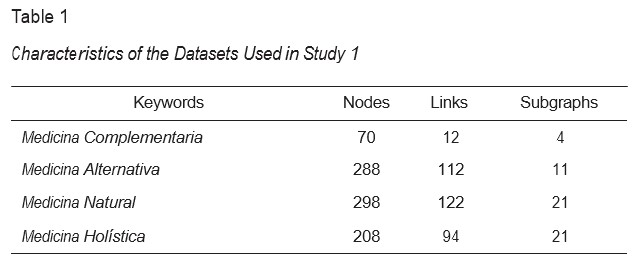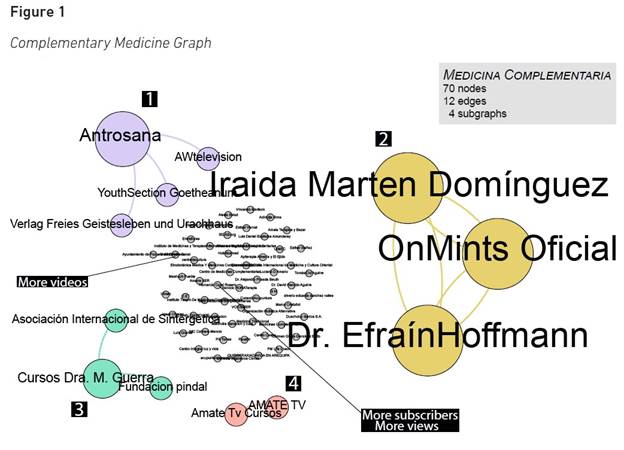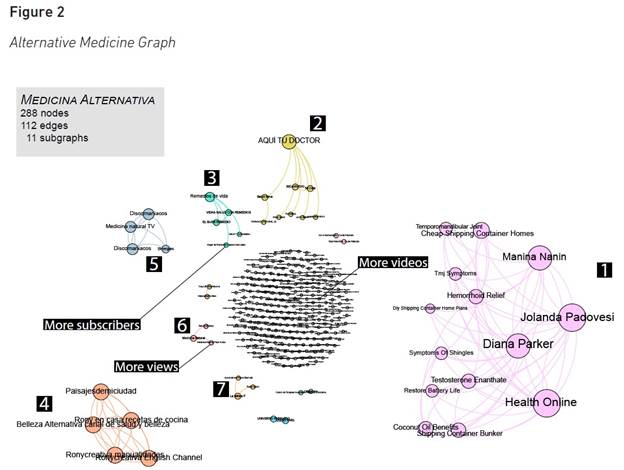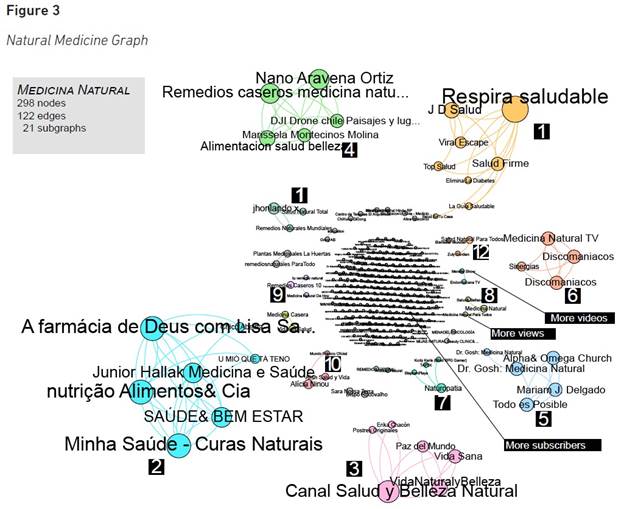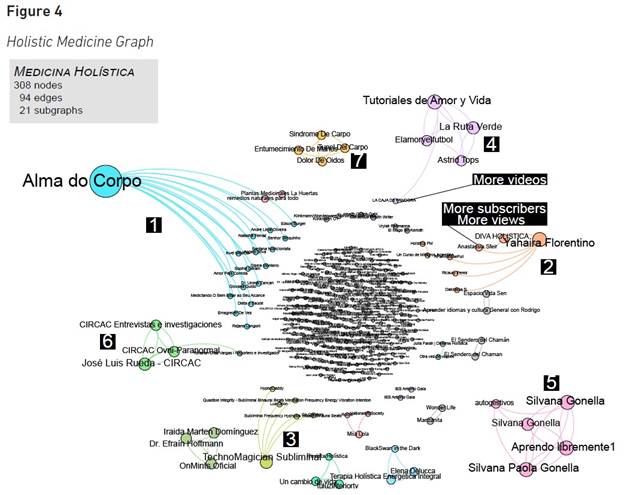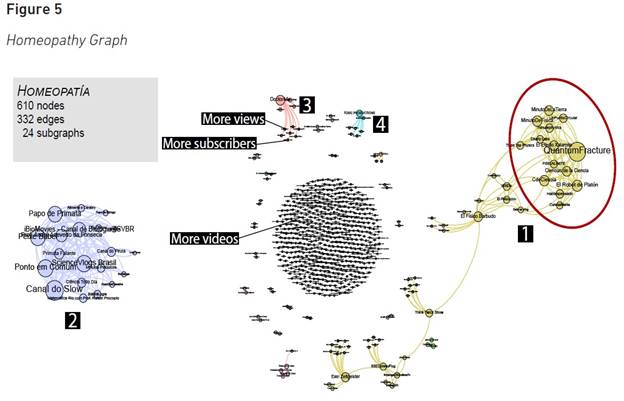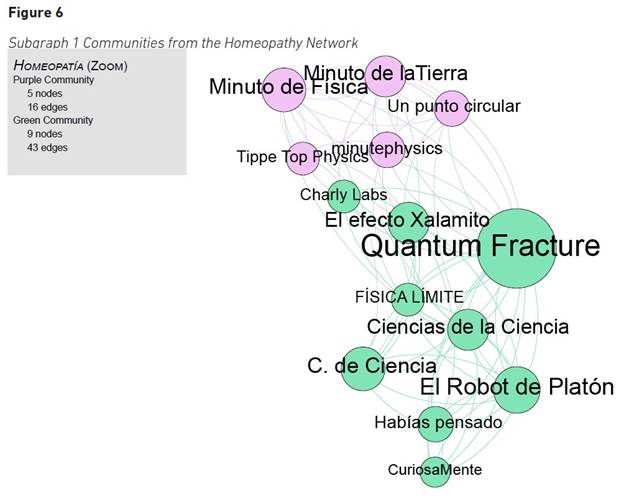INTRODUCTION
Non-conventional medicines or complementary and alternative medicine (CAM) are health practices that fall outside the Western health system because they follow a different logic from contemporary biomedical science, which means that there has been no scientific evidence of their effectiveness (Garrett et al., 2022). Examples of the best-known therapies encompassed within this term include homeopathy, acupuncture, osteopathy and reiki, among others.
The introduction of these therapies in various societies around the world has provoked reactions in favour and against in the public sphere. On the one hand, there is a discourse that supports the use of these therapies and considers them a more natural therapeutic option. On the other hand, there is a discourse against the use of alternative therapies as a valid health treatment, which has been associated with the sceptical movement and has had a substantial impact in countries such as the United Kingdom, Australia and Spain. In these countries, civic groups that argue against unconventional medicine using scientific evidence have managed to convince some universities to eliminate specialist postgraduate degrees in this type of therapies (Brosnan, 2015; Caldwell, 2017; Chatfield et al., 2012). Currently, the sceptical movement is mainly organised through the Internet, using social media to broaden their discourse in order to reach more people (Cano-Orón, 2019; Farley, 2009; Kettell, 2014; Smith & Cimino, 2015). Meanwhile, supporters seem to be apparently less unified and disperse, at least regarding their contribution to these debates on Twitter (Cano-Orón, 2019).
Previous studies suggest that media information on health can influence citizens’ beliefs and attitudes about science (Fishman & Casarett, 2006) and could even affect policy makers and care providers (Weeks & Strudsholm, 2008). The same happens with health information on social media (Hornik et al., 2013; Vaterlaus et al., 2015). Studies show that the main source of information considered by people for using CAM is first friends and acquaintances (word of mouth) and secondly the Internet (Cano-Orón et al., 2019; Evans et al., 2007). YouTube is the second most preferred search engine to seek for information about science and health among online users (Amarasekara & Grant, 2019). Therefore, it is important to explore the contents and messages of its videos.
The innovation in our work lies in the dimension of the agents behind those contents. We focus our attention on the possible content-creator communities that are behind such messages. In this case, a YouTube content creator is defined as the channel owner, the person who uploads original videos and creates a series of personal recommendations through her/his/their channel (featured channels).
The platform allows content creators to choose partnerships and recommend their channels. This is a way of weaving a network of actors that make it possible to act as one block in public debate to defend and promote their speech and agendas. According to Barabási (2016), we understand that a community is strong when it has a specific network structure (e.g., connectedness, density). Moreover, it will be strong if its nodes have cohesion (Moody & White, 2003; Tulin et al., 2018), which means that all of them address the same topic from the same viewpoint.
In the case of CAM, some authors showed that the framing of information spread through conventional media conditioned public debate and had consequences (Caldwell, 2017; Cano-Orón, 2019; Cano-Orón & Lopera-Pareja, 2021). Then, the detection of a community disseminating a message about this topic in one block is important for exploring the public debate about CAM on YouTube.
This article has the following objectives:
1. To map CAM Spanish-speaking content-creator communities on YouTube.
2. To identify the communities generated on CAM-related topics based on the manual recommendation of content creators.
3. To analyse the strong communities-i.e., which nodes have more links within the community than the rest of the graph (Barabási, 2016) in relation to the connections and cohesion of their components.
In order to reach these objectives, we have developed two studies based on a combination of two main approaches: the graph theory and the visual network analysis, which are further explained in Section 1.2.
YouTube as a Channel for Health Content Distribution
People seek information about science and technology through YouTube (or online video platforms), making it the second largest source consulted by people who consume information online (Amarasekara & Grant, 2019). YouTube is increasingly used to share health information and “hosts videos providing information on the pathogenesis, diagnosis, treatment and prevention of various health conditions” (Madathil et al., 2015, p. 190).
YouTube differs from other social network platforms, such as Twitter or Facebook, because it is a hybrid commercial space in which the content generated by users may be monetized (Arthurs et al., 2018). This means that profits are obtained each time a video is played if it follows the policies established by the platform for that purpose-e.g., the content must be an original production, must follow the copyright rules, must not contain offensive or sexually explicit material, etcétera (YouTube Help, 2020). Bärtl (2018) states that comedy, entertainment and “How to & Style” videos receive the most views. These categories cover a broad range of topics, including health. Coincidentally, videos on alternative therapies, specifically chiropractic, have been catalogued under the sections of “How to & Style,” “Comedy” and “Education” (Marcon & Caulfield, 2017).
To date, research on YouTube videos concerning health issues has primarily sought to explore what kind of information and what degree of rigour is used when addressing a particular topic, and to analyse the extent to which this information is useful or harmful to the lay public (Allgaier, 2019; Madathil et al., 2015). Some of the most recent research works include video analyses on alcohol consumption (Barry et al., 2018) and the use of marijuana (Yang et al., 2018), and videos about infertility (Kelly-Hedrick et al., 2018), the prevention of skin cancer (Ruppert et al., 2017), the Zika virus (Basch et al., 2017) and food allergies (Reddy et al., 2018). In general terms, it has been observed so far that, whilst it does largely depend on the subject at hand (Allgaier, 2019; Madathil et al., 2015), the common feature is that most health videos are narrations of personal experiences (Madathil et al., 2015). One example of the poor-quality information that can be found on YouTube is the specific case of vaccines, where most videos take a stand against them (Briones et al., 2012; Donzelli et al., 2018; Venkatraman et al., 2015).
Authors like Caulfield et al. (2019) or Madathil et al. (2015) have highlighted the enormous capacity that social media has to spread misinformation in health-related topics. Madathil et al. (2015) expressed concern about the large number of videos featuring unscientific therapies and remedies on YouTube, and the strong probability that users find them when looking for health information. These videos, which contradict official guidelines, can modify people’s beliefs and behaviours regarding controversial topics such as vaccines, as most videos addressing this issue take a negative stance (Madathil et al., 2015).
As stated by Bortoliero and León (2017, p. 110), “the studies of the scientific rigour of health videos on YouTube show that the lack of scientific rigour is frequent". Unlike other databases such as Google, Wikipedia and PubMed, on YouTube, users can upload their content with no editorial control and it is in these anarchic scenarios where the most alarmist voices, such as those who postulate an anti-vaccine discourse (linking vaccines directly to autism), have a greater presence (Venkatraman et al., 2015).
Regarding the specific topic of CAM content on YouTube, we only found two studies1: one conducted by Marcon and Caulfield (2017), who analyse YouTube comments on videos about chiropractic. In that study, most of the debates raised in the comments addressed the efficacy and legitimacy of chiropractic. And the other one by Yin et al. (2018), who analyse the content of videos on cupping therapy. We noticed the presence of CAM in other studies when looking for information about a specific illness on YouTube (Daabes & Kharbat, 2019; Pithadia et al., 2019); however, it has not been broadly studied on its own.
The literature found on the subject is mainly focused on the message of YouTube videos, but it is also important to begin exploring other aspects of the platform like, for example, to know if there are actors coordinating and disseminating a specific viewpoint. Apart from the specific content that is published or the reactions of the public, it is also vital to explore the structure that these actors weave on YouTube.
Graph Theory and Visual Network Analysis to Find Communities
To deal with a large dataset that require visualisations, Venturini et al. (2015) propose a method of interpreting these graphs viewed through programs such as Gephi (Bastian et al., 2009), based on graphic semiology variables (Bertin, 1967) such as the position, size and colour of links or nodes. The result is a completely large visual graph, which allows the viewer to interpret trends and identify actors, connected components or subgraphs (Venturini et al., 2015, 2019), clusters and communities (Tabassum et al., 2018). This type of technique is widely used to analyse interactions between users of social platforms (Fu et al., 2018).
The visual representations obtained from these networks tend to be shown as connected components with a subgraph structure. In other words, on the understanding that a subgraph is an isolated quantity of connected nodes inside the whole network visualisation, a fully connected subgraph could be a community. A community is “a group of nodes that have a higher likelihood of connecting each other” (Barabási, 2016, p. 322), which we can be easily identified by the closeness of its nodes in its visual representations.
For analysing the community structure, we took into account two metrics: density and cohesion. Density refers to the number of connections or links that the nodes of a network have. A fully dense network is one in which all its nodes are connected to each other (Tabassum et al., 2018). Cohesion refers to the relationships between the actors who end up forming groups (Moody & White, 2003; Tulin et al., 2018). In our case, we establish that cohesive relationships only exist if the nodes share the same position and/or beliefs about CAM. Cohesive groups tend to perform common tasks to achieve the same goal. In the same way, groups that have more cross-connections between individuals are in a better position to impose collective sanctions, coordinate group activities and, for shared norms, to emerge from them (Coleman, 1988; Smith & Payne, 2017).
Sociological discussion may also understand cohesion from a weak-ties perspective (Granovetter, 1977). However, in this case, our frame is that a close-knit network or strong-ties perspective is more appropriate to understand our sample, because content creators need to know each other to achieve a strong community.
The strength of a community is defined by Barabási (2016, p. 326) as follows: “A strong community is a connected subgraph whose nodes have more links to other nodes in the same community that to nodes that belong to other communities". Based on this definition, we understand that a community is strong when the nodes follow this rule, but it also has to have cohesion among its nodes. This cohesion is the key that the community has in order to be strong and to act in one block to disseminate, defend and promote their beliefs, content and agenda in public debate.
The YouTube content creators’ network is interpreted in this study as a graph, with channel owners viewed as nodes and their featured channels as links that allow us to suggest or not the idea of a strong or weak CAM dissemination community. We take the active recommendation system of the channel owners (featured channels)2 as the main data to build the network because “the nature of user recommendations is that users tend to know and collaborate with each other, thus creating a community collaboration, such that there would tend be more reciprocated edges and connected triads” (Torres & Trinidad, 2015, p. 4).
METHODOLOGY
In this study, the network created by YouTube channel owners’ recommendation (featured channels) is regarded as a community, where a channel owner (also called “content creator”) is a node, and a tie or link is the active connection that they made when they recommended their channels in their featured channel list. These networks are directed towards knowing that it will depend on the channel owner to decide who to recommend and, therefore, the relationships could be both bidirectional and unidirectional.
To map the YouTube content creators’ network, we used “YouTube Data Tools” (Rieder, 2017), specifically the Channel Network module, as a data extraction tool. This tool allows for the extraction of channel networks from the “search: list” endpoint and the “channel: list” endpoint of platform API (v3).
This module has two parameters: one requests a search, which can be based on keywords or channels, and organizes the results according to the needs of the study (in this case, the ranking of data by relevance). This search can be requested by a number of iterations up to a maximum of 20; in our case, the number of iterations was 10.
The second parameter determines the depth of the crawling with which the extraction is performed. The user can select a depth of 0 to 2 degrees, so the tool compiles a network of recommended channels and the recommended channels’ recommended channels, depending on the configuration of the parameter. The degree, according to the graph theory, represents the distance of links that nodes have from each other (Barabási, 2016). We selected a depth of 1 because it is not always possible to successfully obtain and visualise a network with too many nodes due to technical limitations, as in our case. This means that our network is composed of the channels that are found with the keywords + the recommended channels + the recommendations of the recommended channels.
Literature on science and health content on YouTube (Allgaier, 2019; Madathil et al., 2015) agrees that the methodology basically used to date has been content analysis and statistical analysis of the metrics offered by the platform (duration, sources, views, reactions of users, etcétera), as well as framing, always applied to small corpora (around a couple of hundreds of videos). Since it is important to concentrate efforts on content analysis, it is also important to explore the social relationships behind those topics due to the capacity of a community to act with a unified speech and agenda.
We chose visual network analysis (Decuypere, 2020; Venturini et al., 2015, 2019) to analyse the community because it allows us to see the connections between content creators and how they relate each other by recommending their channel (see Annex: Analysis Protocol).
Gephi was used to visualise the data (Bastian et al., 2009). The featured channels formed a directed network. Graphs were obtained using the Force Atlas distribution algorithm, with the size of the nodes indicating the degree-i.e., the number of recommendations received by the channel (in-degree) plus the number of recommendations it provides (out-degree). Therefore, the most connected nodes will be larger.
Corpus
This research used two corpora. The first dataset was collected with the intention of achieving the objectives (Study 1), corresponding to searches of networks of CAM content creators. In order to contrast the results, it was decided to collect an additional dataset (Study 2).
All datasets are results of queries made in Spanish. We conducted this research focusing on the Spanish-language sphere because, on the one hand, it is the second mother tongue in the world by number of speakers (after Mandarin Chinese) and its speaking community is composed of more than 580 million people (Instituto Cervantes, 2019). On the other hand, we chose this language because, while in Spain there is a public debate about the regulation of these therapies and there has been an increase in media attention for this issue (Lopera-Pareja & Cano-Orón, 2021), in many Latin American countries some of these practices are well accepted, such as in Mexico (Corell-Dómenech, 2019), or even are part of the native American medicine, such as in Chile (Pérez et al., 2020). As YouTube videos know no borders, it is interesting to analyse the synergies that are created.
Even though the terms searched for were in Spanish, there are channels in other languages in our network. This is either due to connections actively made by the creators or to the fact that the keywords used in Spanish are similar in other languages, such as Portuguese.
Study 1: CAM Content Creators’ Networks
One of the elements considered when designing this research was the fact that there is no consensus on the name to refer to these therapies. Literature, media and social networks refer to them as “alternative,” “complementary,” “natural,” “holistic,” “unconventional,” “soft,” “pseudoscientific,” among others (Falkenberg et al., 2012; Idoyaga, 2005). As Gale (2014) explains, the name used to refer to them also positions and situates them within a specific context; when they are called “complementary” or “alternative,” for example, it is always in relation to Western medicine. Officially, the World Health Organization (2013, p. 16) calls them “traditional and complementary medicines” and the Cochrane Group (Wieland et al., 2011, p. 1), a global reference for meta-analytical studies, calls them “complementary and alternative medicines".
With all this in mind, we chose to analyse the scenario using four commonly used, broad and non-pejorative terminological approaches: “Medicina Complementaria,” “Medicina Alternativa,” “Medicina Natural” and “Medicina Holística” (Table 1). This allowed us to address the various results in a complementary manner and thus map the links between the different channels.
Once a week throughout June 2018 (from June 7 to June 28), on the same day of the week at the same time of the day, a dataset was extracted using the four keywords, aimed at verifying if these networks were having radical or fast changes in a short period of time. After observing that there were no variations among the extracted networks, we chose to use for the analysis the last extracted graph for each keyword, which was the one extracted in the last week of June 2018.
Study 2: Homeopathy Content Creators’ Network
In order to draw contrasts with the type of network generated with keywords that group these therapies under one generic name, we also analysed the network of content creators of one specific therapy. We chose “homeopathy,” as this is one of the therapies that attracts the most attention in public opinion (Cano-Orón, 2019).
This network was extracted using the same parameters as the previous study, once a week, at the same time, from July 28 to August 10, 2018. This dataset features 610 nodes, 332 links and 24 subgraphs.
RESULTS
First, we analysed the subgraphs to assess whether a community existed. To that end, we presented the percentage of the subgraph with respect to the network (to get the perspective of its representation) and its density metric. To be a community, the nodes of the subgraph should have also been related to the topic; that is why we added the description of the nodes if it was relevant to the topic. Afterwards, if a community existed, we observed the cohesion among the nodes to evaluate the strength of the community.
When the CAM community was not detected, we exposed the topic-related channels that were isolated but highlighted by their social media metrics to check if they were CAM communicators and to confirm if they were in our network and were not connecting with other content creators.
Study 1: CAM Content Creators’ Networks
In the graph created for Medicina Complementaria (Figure 1), there were four subgraphs (highlighted in colour) of no more than four nodes; everything else within the network was formed by isolated nodes (in grey). These components neither formed an interconnected network nor constituted a clustering conglomerate.
Subgraph 1 (5,71 % of the network; density 0,25) was led by Antrosana, which was rejected as a community, because this node was the only link between the other nodes.
Subgraph 2 (4,29 %; density 1) and subgraph 3 (4,29 %; density 0,33) were not examined in depth because they were two triads. The same occurred with subgraph 4 (2,86 %; density 0,5), which was composed by a dyad.
As there was no strong CAM community in this network, we looked for the highlighted YouTube channels. In this case, a content creator-an isolated node of the network- was the channel within the network with the most subscribers (65 369) and the most views (148 213). It was a prolific channel about CAM, with 2205 videos uploaded. However, it neither recommended other channels nor was recommended; therefore, it was isolated from the other channels that discussed these topics.
The Medicina Alternativa graph (Figure 2) consisted of 11 subgraphs, seven of which represented more than 1 % of the network.
In this network, there was a great deal of what is popularly known as clickbait3 (Varshney & Vishwakarma, 2021; Zannettou et al., 2018). Specifically, we found it in four of the seven subgraphs, representing a total of 10,76 % of the network (subgraph 1 [4,86 %; density 0,33], subgraph 2 [3,12 %; density 0,12], subgraph 3 [1,74 %; density 0,25] and subgraph 6 [1,04 %; density 0,33]). This content comprised static, generic images of foreign origin with robot voice-overs, which simply stated a list of tips and natural remedies and were generally very focused on aesthetics (wrinkles, weight loss, etcétera). They usually had headings in several languages to attract more viewers and in such a way to awaken the reader’s curiosity as, for example, “It’s not a joke! Do this and your hair will grow in 10 days! Here we show you how” or “Drink this for 3 days and your BELLY FAT will melt like ice cream". Some of these nodes recommended well-established channels with large numbers of followers that were entirely unrelated to CAM, such as Justin Bieber’s and 50 Cent’s channels.
Subgraph 4 (1,74 %; density 1) consisted of a series of channels owned by the same author, who offered advice on different areas related to alternative therapies. Subgraph
5 (1,39 %; density 0,75) and subgraph 7 (1,07 %; density 0,33) were made up of channels whose content was barely related to the topic that the keywords suggested. All these subgraphs did not have cohesion, so they were rejected as a community.
As there was no strong CAM community in this network, we reviewed the social media metrics. The channel that uploaded the most videos (2884) was “Jose Antonio Chavez,” who published content on how to cure various health problems using alternative medicines. However, the number of views was minimal (5532) considering the high number of uploaded videos. The channel that had the most views of the whole graph (excluding Justin Bieber’s and 50 Cent’s channels) was “Natural Medicine for All,” from subsection 6, and the one with the most subscribers was “Hogar de Remedios Caseros Naturales,” from subgraph 3, both of which feature clickbait.
The Medicina Natural graph (Figure 3) consisted of 21 subgraphs and many isolated components. However, just 12 subgraphs represented more than 1 % of the network.
In subgraph 1 (2,68 %; density 0,30) and subgraph 4 (1,68 %; density 0,80), there were communities composed of channels who distributed clickbait videos. As mentioned above, those videos, focused on natural homemade remedies for common problems, were poorly generated with bots and static images. Moreover, their nodes did not have cohesion among them. Subgraph 8 (1,01 %; density 0,33), subgraph 9 (1,01 %; density 0,33), subgraph 11 (1,01 %; density 0,66) and subgraph 12 (1,01 %; 0,33) also published clickbait videos but their nodes did not make up a community.
Subgraph 3 (2,01 %; density 0,46) was a community whose nodes did not have cohesion. The node with the most connections, “Canal Salud y Belleza Natural,” featured contents on food, health and beauty, but the nodes linked to it did not have a related topic (recipes and crafts). The same happened with subgraph 5 (1,68 %; density 0,55), whose main node was “Dr. Gosh: Medicina Natural". However, the community was composed of channels related to the evangelical church. Likewise, subgraphs 6 (1,34 %; density 0,75) and subgraph 7 (1,34 %; density 0,25) comprised channels with unrelated topics; as a result, they were not considered. Subgraph 10 (1,01 %; density 0,50) was a triad whose nodes shared the same channel owner, so it was not a community.
Subgraph 2 (2,35 %; density 0,61) was composed of seven nodes (26 links) and included videos in Portuguese. The presence of this subgraph in the network must have been due to similarities between the keywords used in the search and the language of the creators. This was the only community from the network with cohesion. These channels were developed by naturopaths who mainly addressed the CAM topic.
The largest node was “A farmácia de Deus com Lisa Santos”’ and its content featured advice on health, nutrition and self-care. All the channels of this community published videos of the same topic and even doctors such as Dr. Lair Ribeiro or Dr. Pedro Junior participated or were mentioned in some videos of other channels of the community. All the channels of the community were CAM topic centred and generated content for its promotion.
Another node worth highlighting in subgraph 2 was “Nutrição Alimentos & Cia,” which had the same content pattern as the other components of the subnetwork to which it belonged. In the description of the channel, it mentioned prestigious academic institutions, such as the University of California, and academic databases, such as PubMed, giving the appearance of quality to the information it uploaded in its videos. It is worth mentioning that it also included as a premise that its focus was the use of natural medicine for the prevention of pathologies.
This subgraph was the first in the study to meet the characteristics of a community network of specific content on the subject and its density indicated that it was a strong community. We also found evidence of that in its videos, where channel owners mentioned them, made recommendations, and most of them extolled Dr. Ribeiro. Likewise, all provided a telephone number as a means of having direct communication and buying books written by them. This subgraph presented a solid example of cohesion.
The Medicina Holística graph (Figure 4) consisted of 21 subgraphs, although only seven had more than 1 % of the network.
Subgraph 1 (5,52 %; density 0,05) and subgraph 3 (1,95 %; density 0,16) were connected components which were linked by only one node, so they were rejected as communities. In the case of subgraph 2 (1,95 %; density 0,23), subgraph 4 (1,62 %; density
0,50) and subgraph 6 (1,3 %; density 0,58), the lack of cohesion was the main problem. And, regarding subgraph 5 (1,62 %; density 0,65), because it was composed of nodes of the same channel owner, we rejected it as community from the beginning. Finally, subgraph 7 (1,3 %; density 0,50) consisted of four nodes which recommended each other, so it was a community. Nevertheless, the topics addressed were not CAM related.
In the Medicina Holística graph, all the subgraphs appeared to be communities, but they had no cohesion or were extremely weak. So, in this network there was not a strong community that promoted CAM. Regarding the social media metrics, as the highlighted channels are part of the subgraphs already analysed, it is not substantial to add more information about the isolated nodes.
Study 2: Homeopathy Content Creators’ Network
In the Homeopatía graph (Figure 5), there were 24 subgraphs, although only four of them represented more than 1 % of the network.
Subgraph 1 (8,85 %) was distributed by clusters. The most relevant cluster included two communities (circled in Figure 5 and enlarged in Figure 6). The first community (Figure 6 - in green) had a density of 0,59 and the second one (Figure 6 - in purple) of 0,80. Both community nodes were content creators related to science dissemination. While the green community used Spanish in all its videos, the purple community presented videos in Spanish and English. They were youtubers that were very active and collaborated with each other. They uploaded content almost weekly and went one step further than recommending each other: they actually made collaborative videos. The other clusters connected to these communities (see Figure 5) had cohesion but no relevant density. Nevertheless, it is noteworthy that while one cluster was focused on science dissemination and explained science processes, the others were sceptics and activists addressing science controversies.
The channels demonstrated great cohesion because all of them shared the same point of view and addressed the CAM topic, so this community was against said practices and justified its position with scientific arguments.
Subgraph 2 (3,28 %; density 0,33) was a community composed of science communicators in Portuguese. Even though it had cohesion among its nodes, it was a weak community. Subgraph 3 (1,8 %; density 0,11) and subgraph 4 (1,15 %; density 0,16) were communities but were not topic related.
DISCUSSION
When analysing the results from Study 1 and Study 2, we figure out that the CAM-related network of YouTube content creators tends to consist of lots of isolated nodes and some dyads and triads. This means that content creators publishing videos about CAM, in general, are not evidently connected. If their performance within the networks reflects their offline structure and there is no cohesion among groups or individuals, it is possible to predict that members of this community will struggle to coordinate group activities and establish a series of shared norms (Coleman, 1988; Smith & Payne, 2017).
One explanation could be that there is a broad variety of therapies, all of which are very different from one another, which means that finding a consensus is difficult. It is important to highlight the terminology limitations in the study of this topic at a generic level. In the process of viewing the videos, we detected a very broad lexical field in relation to these therapies, as each content creator chooses to designate the scope and the therapy that he or she addresses differently. This is in addition to the compiling material in order to study such content.
If we analyse the graphs of the general keywords (Study 1), we find that-broadly speaking-the keyword that best fits the expected content is Medicina Natural. In general, content networks on non-conventional therapies in Spanish feature different content depending on the search terms used to identify them. For example, searches for the term Medicina Complementaria generate scarce results that do not refer directly to these types of therapy, which suggests that this term is not widely used to refer to them on YouTube. The search for Medicina Alternativa obtains results which are mostly or very similar to a clickbait, a widespread term for content which serves as a hook. This leads us to believe that there is a large audience seeking “alternatives” to conventional medicine and that this clickbait is posted for financial purposes (Zannettou et al., 2018). The search for Medicina Natural recovers content which is clearly positioned against conventional medicine, including anti-vaccine videos, for example. This is the only keyword that reveals a strong community of content creators which is also not in Spanish but in Portuguese. Likewise, searches for Medicina Holística turn up content which is far more attuned with emotional, psychic and even mystical perspectives.
These results found in Study 1 contrast with the structure identified when using a specific keyword (Study 2). The most outstanding videos in the homeopathy content creators’ network tend to be those which are positioned against the practice. Therefore, surprisingly, the community of channels using the search term homeopatía consist of science communicators, sceptics and atheists. The latter is an example of a cohesive community and contrasts with the results found-in general-in Study 1, which identified mostly isolated connected components that do not interrelate with each other and do not even appear to show interest in such social cohesion, using the platform simply for profit-making purposes.
Generally speaking, as observed in other research (Madathil et al., 2015) on the study of health content on YouTube, the videos present discourses with personal narratives, specifically from youtubers, and there are few professional and informative videos in favour of these therapies (see the results of Studies 1 and 2). However, the communities of science communicators found in Study 2 do offer well-prepared, explanatory videos of great audiovisual quality.
Another observed phenomenon was the unexpected presence of clickbait initiatives that are suspected to have arisen to take advantage of the monetization model. Their main intention is to attract clicks or visits from many users, regardless of these users’ subsequent disappointment (Zannettou et al., 2018). The strategies we detected are in line with the characteristics described by Zannettou et al. (2018). These include, for example, the use of attractive and captivating thumbnails which are irrelevant to the video content, the use of intriguing headlines, or the encapsulation of false information in either the video or the description.
Regarding the scarce number of strong communities obtained (three in all the networks studied here), it is noteworthy that only one of them disseminates a discourse supporting CAM, whereas the two stronger ones are against it. Even though we found one strong community of CAM supporters, it is in Portuguese language, so it does not belong to the Spanish-language community studied here. Even if it is considered, it will be isolated from the rest of the nodes of the network. On the other hand, the two strong communities against CAM in Spanish show to be part of a big subgraph connected to other components with a similar position but coming from other groups (atheists and sceptics), which means that even though the community is well-defined, there are outside connections to that community. In other words, the community is known from outside. This could be reflected in the sense that, for example, disseminating ideas in search of greater cohesion to carry out agendas would be more effective.
This does not mean that there are more videos against CAM on YouTube, but rather the content creators against CAM are better organised in communities than CAM supporters. Therefore, in a public debate, CAM opposition may be in a better position to unify a speech and lead policy and media agendas (Coleman, 1988; Smith & Payne, 2017).
CONCLUSIONS
This research has analysed four networks generated through keywords that are used to designate CAM in general. In those networks, we only found one strong community, which was a CAM supporter. It was isolated from the rest of the components of the network and was in Portuguese. We did not find a strong community in Spanish. In the study of a specific keyword (homeopathy) that addressed only one technique of the whole CAM list of therapies, we found two strong communities in Spanish who were connected to each other and with other components of the network that were outside the community.
Contrarily, there were two strong communities with several connections in Spanish that acted in one block with a shared viewpoint against CAM. We consider that, on YouTube networks derived from these keywords, the only organised group able to distribute a unified message was science communicators (who were against CAM).
These findings show meaningful implications in YouTube CAM dissemination: They are presented through discourses from isolated individuals, which suggest that these therapies are disseminated or constructed by the actor’s own perception, with no support of a community of individuals who confirm that perspective. Our interpretation is that each of them promotes a different and unique understanding of their therapies, and rarely will share a common strategy or specific agenda in public debate, insofar they do not spread a common or united message.
As reflected in the Spanish case on Twitter (Cano-Orón, 2019), the sceptical viewpoint about CAM mobilises, organises and builds a community with social cohesion among its members. In the case studied here, the interconnections between them stem not only from the recommendations made in the featured channel list but also from collaborative video creation and mutual promotion.
The limitations of this study were two. First, the technical dimension in which the data was accessed was quantitatively limited, as the level of depth reached with data mining was not absolute. Secondly, the chosen definition of community (content creators) for this study resulted in one specific type of network, only focused on the channel owner recommendation (feature channels). As YouTube has more ways to interact (subscribers, commenters, etcétera) than the featured channel list, other types of networks could be built with more YouTube data to explore communities. In further research, it could be interesting to consider an expanded definition of community, for example, content creator and subscribers.














